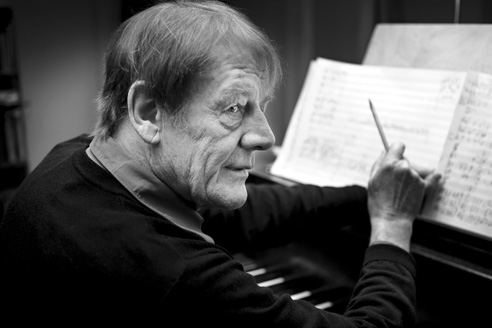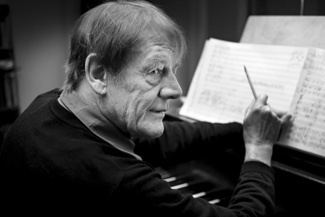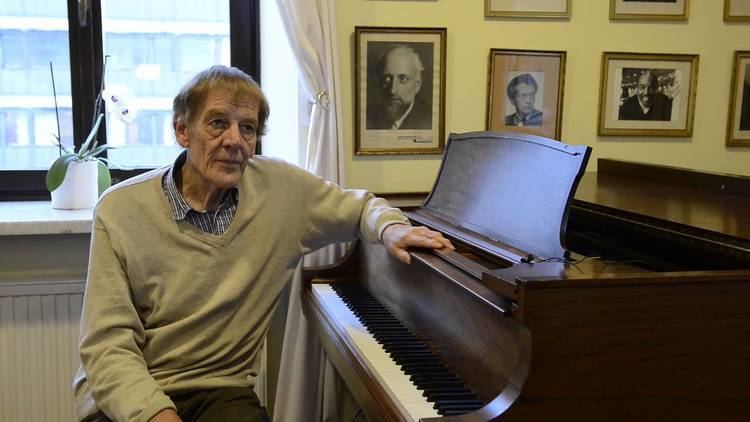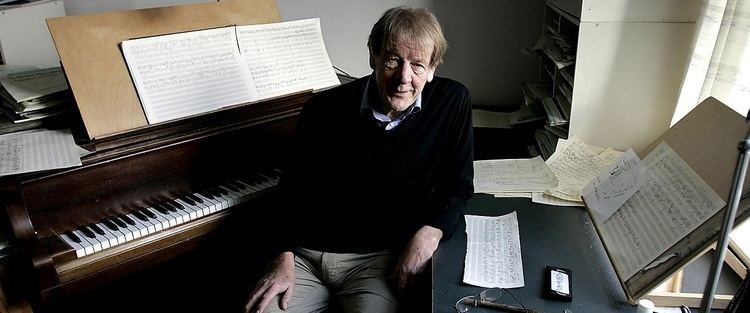Name Per Norgard Role Composer | Siblings Bent Norgard | |
 | ||
Spouse Anelise Brix Thomsen (m. 1956) Parents Erhardt Norgard, Emmely Johanne Nicoline Christensen Compositions Symphony No 3, Symphony No 3, Flos ut rosa floruit, Flos ut rosa floruit, Wie ein Kind: I Wiigen-Lied, Wie ein Kind: I Wiigen-Lied, Winter Hymn, Winter Hymn, Violin Concerto no 2 "Borderlines": II Lento - quieto e quasi semplice, Violin Concerto no 2 "Borderlines": II Lento - quieto e quasi semplice, Sonate breve - sonata for solo cello no 3 "What - is the word!": II Imposante, Sonate breve - sonata for solo cello no 3 "What - is the word!": II Imposante, Sonate breve - sonata for solo cello no 3 "What - is the word!": III Andante, Sonate breve - sonata for solo cello no 3 "What - is the word!": III Andante, En lys time, En lys time, Entwicklungen: No 2 Die Genesende, Entwicklungen: No 2 Die Genesende, Entwicklungen: No 1 Kindheit, Entwicklungen: No 1 Kindheit, Two Recitatives - op 16: No 1 Jag lyssnar till vinden, Two Recitatives - op 16: No 1 Jag lyssnar till vinden, Violin Concerto no 2 "Borderlines": I Moderato, Violin Concerto no 2 "Borderlines": I Moderato, Violin Concerto no 1 "Helle Nacht": II Adagio, Violin Concerto no 1 "Helle Nacht": II Adagio, Sanger fran "Aftonland" - op 17: Part II: No 2: Nu ar det sommermorgon, Sanger fran "Aftonland" - op 17: Part II: No 2: Nu ar det sommermorgon, Sanger fran "Aftonland" - op 17: Part II: No 1: Preludio, Sanger fran "Aftonland" - op 17: Part II: No 1: Preludio, Sanger fran "Aftonland" - op 17: Part III: Det ar om aftonen man bryter upp, Sanger fran "Aftonland" - op 17: Part III: Det ar om aftonen man bryter upp, Sanger fran "Aftonland" - op 17: Part II: No 3: Tacka vill jag, Sanger fran "Aftonland" - op 17: Part II: No 3: Tacka vill jag, Sanger fran "Aftonland" - op 17: Part I: No 3: Det ar om aftonen man bryter upp, Sanger fran "Aftonland" - op 17: Part I: No 3: Det ar om aftonen man bryter upp, Sanger fran "Aftonland" - op 17: Part I: No 1: Allt ar sa underligt fjarran i dag, Sanger fran "Aftonland" - op 17: Part I: No 1: Allt ar sa underligt fjarran i dag, Violin Concerto no 2 "Borderlines": III Andanti semplice, Violin Concerto no 2 "Borderlines": III Andanti semplice, Sanger fran "Aftonland" - op 17: Part I: No 2: Du manniska som star vid stranden av mig, Sanger fran "Aftonland" - op 17: Part I: No 2: Du manniska som star vid stranden av mig, Day and Night: No 2 Silversweet Sound, Day and Night: No 2 Silversweet Sound, Schlafen gehen - Schmerz und Not, Schlafen gehen - Schmerz und Not, Violin Concerto no 1 "Helle Nacht": III Allegretto leggiero, Violin Concerto no 1 "Helle Nacht": III Allegretto leggiero, Violin Concerto no 1 "Helle Nacht": I Allegro moderato, Violin Concerto no 1 "Helle Nacht": I Allegro moderato, Violin Concerto no 1 "Helle Nacht": IV Poco allegro, Violin Concerto no 1 "Helle Nacht": IV Poco allegro, Three Love Songs: No 2 Wie soll ich meine Seele halten, Three Love Songs: No 2 Wie soll ich meine Seele halten, Sonate breve - sonata for solo cello no 3 "What - is the word!": I Lento, Sonate breve - sonata for solo cello no 3 "What - is the word!": I Lento, Three Love Songs: No 1 L\'etoile a pleure rose, Three Love Songs: No 1 L\'etoile a pleure rose, Symphony no 4: I Indian Rose Garden, Symphony no 4: I Indian Rose Garden, Fons laetitiae, Fons laetitiae, Plutonian Ode: II Aria, Plutonian Ode: II Aria, Plutonian Ode: I Recitation, Plutonian Ode: I Recitation, Symphony no 3: II, Symphony no 3: II, Three Love Songs: No 3 Opfer (fragment), Three Love Songs: No 3 Opfer (fragment), Seadrift, Seadrift, Strijkkwartet nr 8, Strijkkwartet nr 8, Day and Night: No 1 A Kill, Day and Night: No 1 A Kill, Strijkkwartet nr 7, Strijkkwartet nr 7, Symphony no 7: II, Symphony no 7: II, Symfonie nr 4, Symfonie nr 4, Wie ein Kind: III Trauermarsch mit einem Unglucksfall, Wie ein Kind: III Trauermarsch mit einem Unglucksfall, Strijkkwartet nr 5, Strijkkwartet nr 5, Symphony no 3: I, Symphony no 3: I, Strijkkwartet nr 3, Strijkkwartet nr 3, Symphony no 4: II Chinese Witch\'s Lake, Symphony no 4: II Chinese Witch\'s Lake, Animals in Concert: I A Tortoise\'s Tango, Animals in Concert: I A Tortoise\'s Tango, Strijkkwartet nr 1, Strijkkwartet nr 1, Strijkkwartet nr 10, Strijkkwartet nr 10, Wie ein Kind: II Fruhlingslied, Wie ein Kind: II Fruhlingslied, Trois chansons de "L\'Amour la poesie": No 2 Les Corbeaux, Trois chansons de "L\'Amour la poesie": No 2 Les Corbeaux Similar People Vagn Holmboe, Carl Nielsen, Thomas Dausgaard, Leif Segerstam, Peter Herresthal | ||
How per n rg rd tricked ligeti into discovering rued langgaard
Per Nørgård (pronounced [ˈpʰeɐ̯ ˈnɶɐ̯ɡ̊ɒːˀ]; born 13 July 1932) is a Danish composer.
Contents
- How per n rg rd tricked ligeti into discovering rued langgaard
- Composer s festival 2012 per n rga rd
- Biography
- Music
- Symphonies
- Concerti
- Operas
- Selected other works
- Awards
- References
Composer s festival 2012 per n rga rd
Biography
Nørgård was born in Gentofte, Denmark. He studied with Vagn Holmboe at the Royal Danish Academy of Music in Copenhagen, and subsequently with Nadia Boulanger in Paris. To begin with, he was strongly influenced by the Nordic styles of Jean Sibelius, Carl Nielsen and Vagn Holmboe. In the 1960s, Nørgård began exploring the modernist techniques of central Europe, eventually developing a serial compositional system based on the "infinity series" (Nørgård 1975), which he used in his Voyage into the Golden Screen, the Second and Third Symphonies, I Ching, and other works of the late 1960s and 70s (Mortensen n.d.(a)). Later he became interested in the Swiss artist Adolf Wölfli, who inspired many of Nørgård's works (Anon n.d.), including the Fourth Symphony, the opera Det Guddommelige Tivoli and Papalagi for solo guitar.

Nørgård has composed works in all major genres: six operas, two ballets, eight symphonies and other pieces for orchestra, several concertos, choral and vocal works, a very large number of chamber works (among them ten string quartets) and several solo instrumental works. These include a number of works for the guitar, mostly written for the Danish guitarist Erling Møldrup: In Memory Of... (1978), Papalagi (1981), a series of suites called Tales from a Hand (1985–2001), Early Morn (1997–98) and Rondino Amorino (1999). One of his most important works for percussion solo is I Ching (1982) for the Danish percussionist Gert Mortensen. He has also composed music for several films, including The Red Cloak (1966), Babette's Feast (1987), and Hamlet, Prince of Denmark (1993).

His eighth symphony was premiered on 19 September 2012 in the Helsinki Music Centre, Finland, by the Helsinki Philharmonic Orchestra conducted by John Storgårds. Heikki Valska from the Finnish radio described the symphony as »very bright and lyrical« and »approachable«. It was well received by the audience at the premiere (Anon. 2012).
Nørgård is also a prolific writer. He has written many articles dealing with music not only from a technical but also a philosophical viewpoint.
Music
Nørgård's music often features the use of the infinity series (Danish Uendelighedsrækken) for serializing melody, harmony, and rhythm in musical composition. The method takes its name from the endlessly self-similar nature of the resulting musical material (Mortensen n.d.(b)), comparable to fractal geometry. Mathematically, the infinity series is an integer sequence. The first few terms of its simplest form are 0, 1, −1, 2, 1, 0, −2, 3, … (sequence A004718 in the OEIS).

Nørgård discovered the melodic infinity series in 1959 and it proved an inspiration for many of his works during the 1960s. However, it was not until his Voyage into the Golden Screen for small ensemble (1968)—which has been identified as the first "properly instrumental piece of spectral composition" (Anderson 2000, 14)—and Symphony No. 2 (1970) that it provided the structure for an entire work (Nørgård 1975, 9). The harmonic and rhythmic infinity series were developed in the early 1970s and the three series were first integrated in Nørgård's Symphony No. 3.
